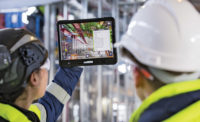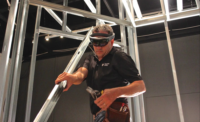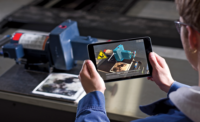Working on a 2D screen for 3D design work has always had its limitations, and in recent years virtual-reality and mixed-reality headsets have promised users greater immersion in the models they are building. But sometimes you just want to use your usual design software within the immersive simulation, and working in MR or VR generally means you can’t use a keyboard or mouse easily.
That’s where the Varjo XR-1 headset comes in. With forward facing cameras to pass a high-definition view of the user’s surroundings into the headset, the XR-1 allows for projected images to be anchored in the surrounding area, at a higher resolution than many current headsets are capable of displaying.
But more importantly, the XR-1 pushes out a high-enough-resolution image to properly see what’s around you while interacting with sharply detailed 3D models. In fact, engineers at Volvo Cars have worn the headset while driving a car on a test track, allowing them to try out conceptual dashboard designs while operating a moving vehicle.
“This is the worlds first proper mixed-reality headset,” asserts Urho Konttori, Varjo’s founder and chief product officer. “It’s photorealistic, the software [you are using inside it] is proper software.” Compatible with Autodesk VRED, Unity and Unreal 3D visualization engines, the headset can project full 3D models into the user’s surroundings with no limitations to their field of view.
Some mixed-reality headsets, such as Microsoft’s HoloLens, project images onto a transparent viewing pane in front of the user’s eyes, situating the 3D image within their surroundings in a limited field-of-view. The pass-through imaging method of the Varjo XR-1 headset projects a blend of the live feed from the headset’s cameras and 3D images, creating a more seamless environment.
Using an enclosed headset does come at the cost of full situational awareness, and Konttori says the XR-1 is best suited for dedicated VR spaces and offices where obstacles and trip hazards can be kept to a minimum (Volvo test tracks notwithstanding).
In a live demo, Konttori walked ENR through the company’s new Dimensional Interface, which allows for regular, 2D Microsoft Windows applications to run within the mixed-reality environment at a high resolution. When working in a program such as AutoCAD or other existing design software, users can see the full 3D model in front of them, while still having access to the application’s traditional 2D workspace as a floating pane.
“It’s the world’s first interface where you are able to operate inside the 3D environment, and have full access to the powerful 2D tools that you have always been using—you are directly linked to this immersive world,” says Konttori. “It allows you to operate exactly the same way as before, no new learning needed.” The high-resolution 2D screens seen floating before the user are comparable to modern PC monitors, offering the equivalent of 4K resolution.
The Dimensional Interface can be used in a mixed-reality mode with the user’s surroundings still visible, or as an isolated, virtual-reality mode. ENR tried out the Dimensional Interface using the XR-1 headset, and the mixed-reality view was functional enough to use regular 2D design software. A 3D CAD program was visible on a screen that appeared to be about 5 ft tall, and the various dialog boxes and other small text fields were fully legible, a feat not accomplished by most other VR headsets.
The text on a real keyboard on a desk was also legible, allowing for the mixed-reality experience of working on a real keyboard and mouse while looking at a virtual display only visible to the user. This is a workflow that has been promised by VR developers for decades, and Konttori says Varjo has largely solved the image-resolution and spatial-tracking problems that have held the technology back.
The XR-1 is currently only available as a developer’s toolkit, and Konttori recommends it for companies that are prepared to develop their own custom software to work with it. “You should have your own development capability if you want to use this,” he says. While the company has had most of its past success in the automotive and aerospace sectors, Konttori says Varjo is highly interested in breaking into the construction industry. Varjo has given demonstrations and delivered earlier models to industry design firms in the past, with mixed success. Konttori hopes the Dimensional Interface and XR-1 will be the breakthroughs that sees these headsets used for more than just design review and marketing presentations.
Currently the XR-1 headset requires beacons, this case SteamVR Base Stations, to be placed around the workspace for tracking purposes. Other recent headsets, such as the Microsoft HoloLens or the Oculus Quest, offer inside-out tracking capabilities, with no need for beacons. Konttori said this was necessary to keep the headset to a relatively small form factor, but he does not rule out a future version without outside tracking beacons. The developer edition XR-1 headset also still has a cable running to the PC that the user must be mindful of while moving around, but Konttori says a wireless version is in the works.
The XR-1 Developer Edition is available on Varjo’s website for $9,995, with a separate $1,995 fee for software and support. No price or release date has been announced for the final model.







Post a comment to this article
Report Abusive Comment